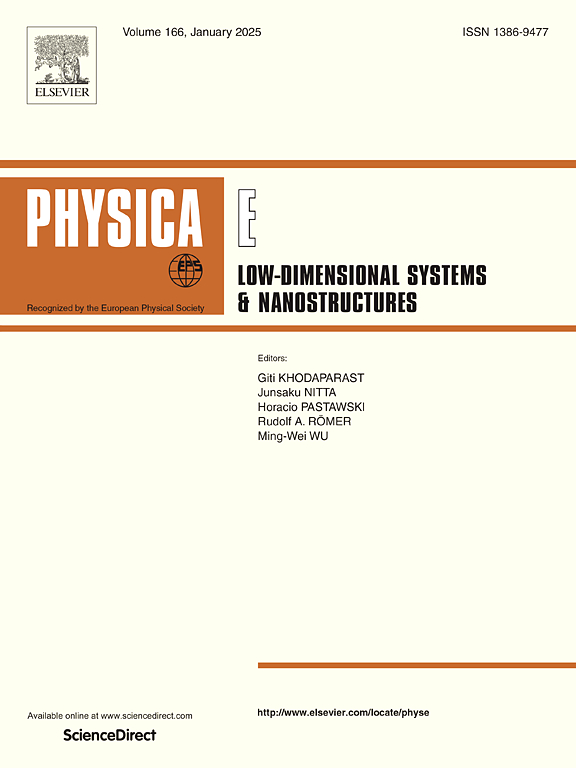Optoelectronic properties of two-dimensional lead-free perovskite Cs3Sb2I9/InX (X = S, Se) van der Waals heterostructures
IF 2.9
3区 物理与天体物理
Q3 NANOSCIENCE & NANOTECHNOLOGY
Physica E-low-dimensional Systems & Nanostructures
Pub Date : 2025-07-24
DOI:10.1016/j.physe.2025.116338
引用次数: 0
Abstract
Low-dimensional halide perovskite semiconductor materials have attracted much attention from researchers due to their unique physicochemical properties that distinguish them from conventional semiconductor materials, but most of the current low-dimensional metal halide perovskite materials contain elemental lead, which hinders their large-scale use. Here, we introduce a two-dimensional lead-free perovskite Cs3Sb2I9 and further construct a Cs3Sb2I9/InX (X = S, Se) heterostructure based on the density-functional theory to investigate its electrical and optical properties. The magnitude of van der Waals forces between the layers of the heterostructure was analyzed by calculating the variation of the binding energy with the layer spacing. The projected energy bands and projected density of states of the heterostructures show that both heterostructures have a type-II energy band alignment at the interface. The calculated differential charge densities show the charge transfer process in the heterostructures, and the results indicate that the charge transfer mainly occurs at the interface and the electrons mainly accumulate in the InX layer. In addition, the light absorption coefficient and dielectric function of the heterostructure are significantly improved compared with those of the isolated material. Especially in the ultraviolet (UV) region, the peak absorption coefficient of the heterojunction can reach 4.16 × 105 cm−1. Subsequently, the response behavior of the heterostructure devices to different wavelengths of incident light was investigated, and the two devices showed peak responsivity of 21 mA/W and 34 mA/W at 3.4 eV and 3.95 eV, respectively. The results of our study suggest that the Cs3Sb2I9/InX (X = S, Se) heterostructure has the potential to be applied in UV photodetector devices.
二维无铅钙钛矿Cs3Sb2I9/InX (X = S, Se)范德华异质结构的光电性质
低维卤化物钙钛矿半导体材料因其独特的物理化学性质而受到研究人员的广泛关注,但目前大多数低维金属卤化物钙钛矿材料都含有元素铅,阻碍了其大规模应用。本文引入二维无铅钙钛矿Cs3Sb2I9,并基于密度泛函理论构建Cs3Sb2I9/InX (X = S, Se)异质结构,研究其电学和光学性质。通过计算结合能随层间距的变化,分析了异质结构层间范德华力的大小。异质结构的投射能带和态的投射密度表明,两种异质结构在界面处都具有ii型能带对准。计算得到的电荷密度微分显示了异质结构中的电荷转移过程,结果表明,电荷转移主要发生在界面处,电子主要聚集在InX层中。与隔离材料相比,异质结构的光吸收系数和介电函数有了显著提高。特别是在紫外区,异质结的峰值吸收系数可达4.16 × 105 cm−1。随后,研究了异质结构器件对不同波长入射光的响应行为,两种器件在3.4 eV和3.95 eV下的峰值响应率分别为21 mA/W和34 mA/W。研究结果表明,Cs3Sb2I9/InX (X = S, Se)异质结构具有应用于紫外光电探测器器件的潜力。
本文章由计算机程序翻译,如有差异,请以英文原文为准。
求助全文
约1分钟内获得全文
求助全文
来源期刊
CiteScore
7.30
自引率
6.10%
发文量
356
审稿时长
65 days
期刊介绍:
Physica E: Low-dimensional systems and nanostructures contains papers and invited review articles on the fundamental and applied aspects of physics in low-dimensional electron systems, in semiconductor heterostructures, oxide interfaces, quantum wells and superlattices, quantum wires and dots, novel quantum states of matter such as topological insulators, and Weyl semimetals.
Both theoretical and experimental contributions are invited. Topics suitable for publication in this journal include spin related phenomena, optical and transport properties, many-body effects, integer and fractional quantum Hall effects, quantum spin Hall effect, single electron effects and devices, Majorana fermions, and other novel phenomena.
Keywords:
• topological insulators/superconductors, majorana fermions, Wyel semimetals;
• quantum and neuromorphic computing/quantum information physics and devices based on low dimensional systems;
• layered superconductivity, low dimensional systems with superconducting proximity effect;
• 2D materials such as transition metal dichalcogenides;
• oxide heterostructures including ZnO, SrTiO3 etc;
• carbon nanostructures (graphene, carbon nanotubes, diamond NV center, etc.)
• quantum wells and superlattices;
• quantum Hall effect, quantum spin Hall effect, quantum anomalous Hall effect;
• optical- and phonons-related phenomena;
• magnetic-semiconductor structures;
• charge/spin-, magnon-, skyrmion-, Cooper pair- and majorana fermion- transport and tunneling;
• ultra-fast nonlinear optical phenomena;
• novel devices and applications (such as high performance sensor, solar cell, etc);
• novel growth and fabrication techniques for nanostructures

 求助内容:
求助内容: 应助结果提醒方式:
应助结果提醒方式:


